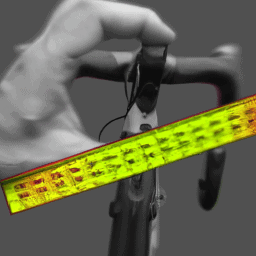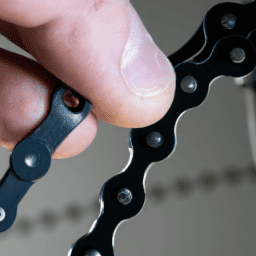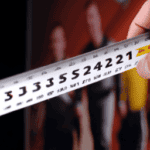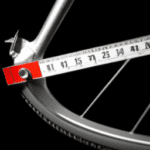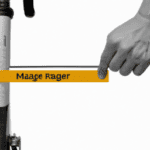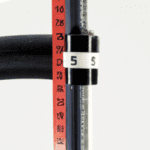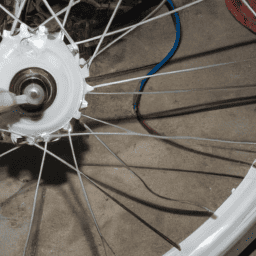As someone who enjoys cycling, I understand how essential it is to have a bike that fits properly for both a comfortable journey and peak performance. Riding a bike that doesn’t fit well can lead to discomfort, pain, and potentially injuries.
That’s why it’s important to know how to measure your bicycle frame size accurately. Measuring your bike frame size may seem like a daunting task, but it’s actually quite simple.
By following a few easy steps, you can determine the correct frame size for your body type and riding style. In this article, I’ll guide you through the process of measuring your bike frame size, from determining your inseam measurement to considering the type of bike you need.
So, whether you’re a seasoned cyclist or just starting out, read on to learn how to measure your bike frame size and achieve the perfect fit.
Key Takeaways
- Measuring bike frame size is crucial for a proper bike fit and riding comfort.
- Seat tube length should be measured with a tape measure and converted to metric units.
- Bike frame size should be chosen based on riding style, body type, and performance goals.
- Inseam measurement is key to finding the right frame size and should be taken into consideration.
Understand the Importance of Proper Bike Fit
It’s crucial to get the right bike fit if you want to avoid discomfort and injury while cycling. The importance of bike fit cannot be overstated.
It’s not just about comfort, but also about maximizing your performance. A proper bike fit can help you avoid injuries, ride faster, and ride for longer periods of time without experiencing fatigue.
To achieve the best bike fit possible, it’s recommended to seek the services of a professional bike fitting specialist. The benefits of professional fitting services are numerous.
They have the expertise and experience to properly adjust your bike’s frame size, saddle height, handlebar position, and pedals to your body’s unique measurements. This ensures that your bike is optimized for your riding style, body type, and performance goals.
With the right bike fit, you’ll be able to ride with greater efficiency and comfort. Now, let’s move on to the next step of determining your inseam measurement.
Determine Your Inseam Measurement
Find out how your legs can make or break your biking experience! Knowing your inseam measurement is crucial to finding the perfect fit for your ride.
Your inseam is the distance from the floor to the inside of your leg, where it meets your pelvis. Maximizing comfort and improving performance is all about having the right frame size and choosing the right saddle height. If your bike is too big or too small, it can cause discomfort and even injury.
By measuring your inseam, you can determine the appropriate frame size that will provide the best fit for you. This measurement will also help you choose the correct saddle height, which is essential for efficient pedaling and maximum power transfer.
Once you have your inseam measurement, you can move on to measuring the seat tube length to find the perfect bike for you.
Measure the Seat Tube Length
To measure the seat tube length of a bicycle frame, I recommend using a tape measure. This will allow for accurate and precise measurements.
It’s important to note that the measurements should be converted to metric units for consistency and clarity in communication with others.
Use a Tape Measure
First, grab your tape measure and get ready to discover the perfect frame size for your bicycle. Using a tape measure is one of the most common and accurate ways to measure frame size. However, it’s important to take note of some common mistakes that can affect the measuring accuracy.
To start, make sure that the tape measure is straight and not twisted or bent while measuring. The tape measure should be placed at the center of the bottom bracket and pulled up towards the top of the seat tube. Make sure to measure to the top of the seat tube, where the seat post meets the frame.
Take note of the measurement in inches or centimeters, depending on your preference. With this measurement, you can now proceed to the next step and convert it to metric units.
Without skipping a beat, it’s important to convert your frame size to metric units to ensure that you have the right fit.
Convert to Metric Units
Now that you’ve got your measurement, it’s time to see how it fits in the metric system. Converting your measurement to metric units is crucial in ensuring that you get the perfect-sized bike frame for your ride.
To do this, you need to convert inches to millimeters. One inch is equivalent to 25.4 millimeters. For example, if your measurement is 18 inches, you multiply it by 25.4 to get 457.2 millimeters. This is your frame size in metric units.
Unit conversion tips can be helpful in ensuring accuracy when measuring your bike frame size. It’s essential to double-check your calculations to avoid common mistakes, such as rounding up or down the numbers.
Precision is key when it comes to getting the right fit for your bike. Once you have your measurement in millimeters, you can proceed to consider the type of bike that you want to ride.
Consider the Type of Bike
When considering the type of bike, there are three main categories to keep in mind: road bikes, mountain bikes, and hybrid bikes.
Each type has its own unique characteristics and is designed for specific purposes. Road bikes are built for speed and efficiency on paved roads. Mountain bikes are meant for off-road adventures with their sturdy frames and suspension systems. Hybrid bikes offer a combination of both worlds, suitable for casual rides or commuting.
Road Bikes
To find the correct size for your road bike frame, you’ll want to measure the distance from the center of the bottom bracket to the top of the seat tube, as well as the length of the top tube. Bicycle frame geometry can vary depending on the type of bike and frame materials used.
Road bikes typically have a more aggressive geometry, with a longer top tube and shorter head tube, which allows for a more aerodynamic riding position.
When measuring a road bike frame, it’s important to consider the following:
-
Stand over the bike with both feet on the ground and make sure there is a few centimeters of clearance between you and the top tube.
-
Measure the distance from the center of the bottom bracket to the top of the seat tube. This measurement is known as the seat tube length and is typically measured in centimeters.
-
Measure the length of the top tube, which is the horizontal distance from the center of the head tube to the center of the seat tube. This measurement is also typically measured in centimeters.
Moving on to mountain bikes, it’s important to note that their geometry is typically more relaxed, with a shorter top tube and taller head tube, which allows for a more upright riding position.
Mountain Bikes
For the optimal fit of your mountain bike, ensure that you have ample clearance between your body and the top tube, and consider the more relaxed geometry of the frame. Mountain bike sizing can be a bit more complex than road bike sizing, as there are different styles of mountain bikes to consider, such as cross-country, trail, and downhill. The right size frame for you will depend on your riding style, height, and inseam length.
When choosing the right frame, take into account the standover height, or the height of the top tube from the ground. This is important for safety reasons, as you want to ensure that you have enough clearance when dismounting or in case of a sudden stop. Additionally, consider the reach, or the distance from the saddle to the handlebars. This will affect your riding position and comfort on the bike. A more relaxed geometry, with a shorter reach and taller stack height, is often preferred for trail riding, while a longer reach and lower stack height may be more suitable for cross-country racing.
| Standover Height (inches) | Rider Height (feet/inches) | Recommended Frame Size (inches) |
|---|---|---|
| Less than 27 | 4’10"- 5’2" | 13-14 |
| 27-29 | 5’3"- 5’6" | 15-16 |
| 29-31 | 5’7"- 5’10" | 17-18 |
| 31+ | 5’11"- 6’2" | 19-20 |
Moving on to hybrid bikes, it’s important to note that they often have a more upright riding position and a combination of road and mountain bike features.
Hybrid Bikes
Moving on from mountain bikes, let’s talk about hybrid bikes. As someone who frequently uses a bike for commuting and leisure, I find hybrid bikes to be a great option for their versatility and comfort.
Hybrid bike features typically include a lightweight frame, wider tires for stability on different terrains, and an upright riding position for better visibility and less strain on the back.
When choosing the right hybrid bike, it’s important to consider your needs and preferences. Are you looking for a bike for commuting, fitness, or leisurely rides? Do you plan on riding on mostly paved roads or do you need a bike that can handle some off-road trails? These factors will impact the type of hybrid bike you choose.
Additionally, it’s important to pay attention to the frame size to ensure a comfortable ride. A bike that is too small or too big can cause discomfort and affect your ability to ride efficiently.
As you consider different hybrid bike options, make sure to take note of the frame size and other features that are important to you. Once you’ve made your purchase, it’s important to test ride and adjust as needed to ensure a comfortable and safe riding experience.
Test Ride and Adjust as Needed
Well, aren’t you just a daredevil? Hop on that bike and take it for a spin to see if it fits you just right. This is the ultimate test to determine if your bike frame size is appropriate for your body.
While riding, you’ll be able to feel if the handlebars and saddle height need to be adjusted. These are the two most important adjustments you can make to ensure a comfortable and safe ride. Adjusting the handlebars is crucial to avoid unnecessary strain on your back, neck, and shoulders. The handlebars should be positioned in a way that allows you to maintain a natural posture without having to lean too far forward.
Similarly, the saddle height should be adjusted so that your legs are properly extended when pedaling. If your legs are too bent or too straight, you’ll experience discomfort and may even cause injury. So, take your time during the test ride to fine-tune these adjustments until you find the perfect fit.
Frequently Asked Questions
What are the different types of bike frames available in the market?
As a cycling enthusiast, I can tell you that the most popular bike frame materials in 2021 are steel, aluminum, titanium, and carbon fiber. Carbon frames offer the advantage of being lightweight but steel frames are more durable.
How do I know if the frame size I have chosen is appropriate for my height and weight?
Feeling confident on your bike is key. A frame size calculator can help determine the right size for your height and weight. Don’t forget the importance of standover height for a comfortable ride.
What is the significance of the top tube length in determining the frame size?
The top tube length is important in bike fit as it determines the reach and cockpit area. Measuring inseam accurately helps to determine the appropriate frame size in relation to the top tube length.
How do I adjust the saddle height and position for optimal comfort and performance?
To optimize comfort and performance, I adjust handlebar height and choose the right saddle. I ensure proper saddle height by placing my heel on the pedal at its lowest point and adjusting the saddle until my leg is almost fully extended.
Can I use the same frame size for different types of bikes, such as road and mountain bikes?
Using the same frame size for different types of bikes is not recommended due to bike frame compatibility issues. Size variation in different bike types affects the geometry and handling, resulting in discomfort and poor performance.
Conclusion
In conclusion, measuring a bicycle frame size is crucial to ensure a comfortable and safe ride. As a cyclist, I’ve experienced firsthand how an ill-fitting bike can lead to discomfort, pain, and even injury.
By determining your inseam measurement and measuring the seat tube length, you can find a bike that fits you properly. It’s also important to consider the type of bike you need, whether it’s a road bike, mountain bike, or hybrid.
As you test ride and adjust your bike, remember that proper fit isn’t just about comfort, but also about efficiency. A well-fitted bike can improve your power transfer and reduce fatigue, allowing you to ride longer and harder.
So, take the time to measure your bike frame size and find the perfect fit. As the famous cyclist Greg LeMond once said, "It never gets easier, you just go faster."With a properly fitted bike, you can ride faster and farther than ever before.
